Mouthguards
Whether you wear braces or not, protecting your smile while playing sports is essential. Sports related injuries to the mouth and jaw are some of the most common injuries received by athletes. Mouthguards help protect your teeth and gums from injury. If you participate in basketball, boxing, hockey, football, gymnastics, lacrosse, martial arts, racquetball, rugby, track and field, skateboarding, skiing and snowboarding, skydiving, soccer, surfing, volleyball, water polo, weightlifting, wrestling, it is recommended by the American Dental Association that you wear a mouthguard.
Types of mouthguards
Choosing the right mouthguard is essential. There are three basic types of mouthguards: the pre-made mouthguard, the “boil-and-bite” fitted mouthguard, and a custom-made mouthguard from your dentist. When you chose a mouthguard, be sure to pick one that is tear-resistant, comfortable and well fitted for your mouth, easy to keep clean, and does not prevent you from breathing properly. If you wear braces or a retainer, it is imperative for you to wear a mouthguard. Your dentist can show you how to wear a mouthguard properly and how to choose the right mouthguard to protect your smile.
Taking care of your mouthguard
Similar to a retainer, braces, or any other special dental appliance, it is important to take care of your mouthguard by storing it properly and keeping it clean, as well as knowing when to replace your old mouthguard with a new one. Here are a few simple ways to keep your mouthguard clean and working correctly:
- Gently scrub your mouthguard after each use with a toothbrush and toothpaste.
- Store your mouthguard in a protective case.
- Do not leave your mouthguard in the sun or in hot water, it may melt or become deformed.
- Replace your mouthguard at the beginning of every new sports season. You should also replace your mouthguard if you notice it has become worn and not longer fits properly.
- Do not wear a retainer with your mouthguard. If you wear braces, your dentist will help design a mouthguard to protect your teeth and your braces.
- Do no chew on or cut pieces off of your mouthguard. Mouthguards come in different shapes and sizes, ask your dentist which is best for you.
- Bring your mouthguard to each dental checkup, and your dentist can check to make sure it's still in good shape!
Our goal is to help minimize your chances of a sports related injury to your smile. Be sure to ask your dentist about mouthguards at your next dental checkup - GO TEAM!
NTI Tension Suppression System
The FDA has cleared for marketing for the first time, a device that prevents medically diagnosed migraine pain, tension-type headache, and jaw disorders ("TMJ"), without drugs or surgery, through the reduction of trigeminally innervated muscular activity.
Migraine Prevention -- Headache Prevention
The N.T.I. Tension Suppression System is a prefabricated polycarbonate matrix that a dental practitioner retro-fits to the patient's teeth . It is completely different from any other type of mouthpiece. Here's the rationale.
 Chronic symptoms of the head and neck can often be attributed to:
Chronic symptoms of the head and neck can often be attributed to:
A) Headache -- the temporalis muscle (it closes and clenches the jaw)
B) Sinus pressure and pain -- the lateral pterygoid muscles (it moves the jaw side to side and/or forward)
C) Neck stiffness and pain -- trapezius muscle (it stabilizes the skull during jaw clenching and grinding)
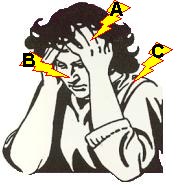 Contraction of the lateral pterygoid (B, above) simply moves the jaw sideways (or if both contract, front wards). If the temporalis (A, above) contracts simultaneously (clenching), the intensity of the temporalis contraction dictates the degree of resistance the lateral pterygoids encounter when they attempt to move the jaw sideways (grinding). As temporalis contraction intensity increases, the lateral pterygoids must work harder, creating symptoms where the lateral pterygoid muscle is attached: atthe jaw joint and sinuses. This conflicting and/or isometric contracting of the musculature (called "parafunction", which occurs during sleep with considerable intensities) obligates the trapezius (across your upper back and shoulders and attaches at the base of the skull, C, above) to maintain a tightened posture, thereby causing stiff and sore shoulders and/or neck.
Contraction of the lateral pterygoid (B, above) simply moves the jaw sideways (or if both contract, front wards). If the temporalis (A, above) contracts simultaneously (clenching), the intensity of the temporalis contraction dictates the degree of resistance the lateral pterygoids encounter when they attempt to move the jaw sideways (grinding). As temporalis contraction intensity increases, the lateral pterygoids must work harder, creating symptoms where the lateral pterygoid muscle is attached: atthe jaw joint and sinuses. This conflicting and/or isometric contracting of the musculature (called "parafunction", which occurs during sleep with considerable intensities) obligates the trapezius (across your upper back and shoulders and attaches at the base of the skull, C, above) to maintain a tightened posture, thereby causing stiff and sore shoulders and/or neck.
When there is temporalis contraction (clenching) exclusively (no lateral pterygoid activity, that is, not sideways of forward movement), the jaw joint and sinuses are less strained, while resultant temporalis pain may be considerable. Tension-type headache patients without jaw disorders clench their jaws 14 times more intensely while sleeping than do asymptomatic controls You can feel your temporalis muscles bulging out when clenching vigorously.
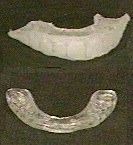 "Traditional" full coverage dental mouthpieces.
"Traditional" full coverage dental mouthpieces.
Top: Soft and covers over the entire arch Bottom: Hard and covers only the biting surfaces
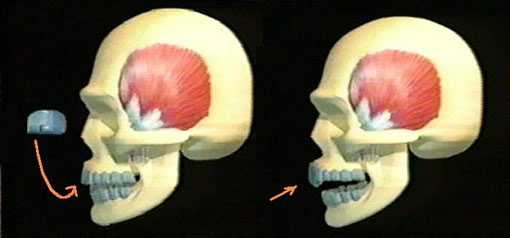 A traditional dental mouthpiece, or splint, reduces the resistance to side-to-side movement thereby reducing the effort and resultant strain to the jaw joint and sinuses (so long as clenching intensity isn't too intense). However, the same splint also provides an ideal clenching surface, where maximum clenching intensity may increase and/or allow jaw joint problems to perpetuate.
A traditional dental mouthpiece, or splint, reduces the resistance to side-to-side movement thereby reducing the effort and resultant strain to the jaw joint and sinuses (so long as clenching intensity isn't too intense). However, the same splint also provides an ideal clenching surface, where maximum clenching intensity may increase and/or allow jaw joint problems to perpetuate.
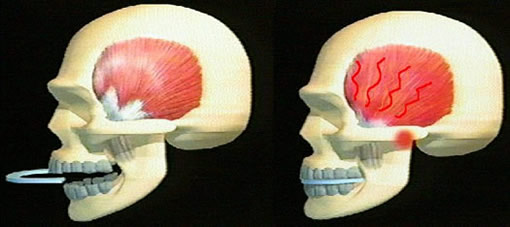
The NTI device is a pre-fabricated matrix that your dentist retro-fits and customizes to your front teeth (sometimes the device is adapted to the lower front teeth...it will still work the same).
If only the front teeth are engaged (like biting on a pencil, for example), the temporalis is prevented from achieving its maximum contraction intensity!
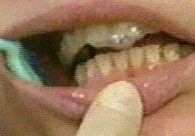 The NTI device snaps into place and fits comfortably on either the upper or lower front teeth. It is worn during sleep and prevents the intensity of muscular parafunction. For migraine sufferers, there is a more discreet version for daytime use, which is usually required (in addition to the pictured nighttime device) for 6 to 8 weeks for best results.
The NTI device snaps into place and fits comfortably on either the upper or lower front teeth. It is worn during sleep and prevents the intensity of muscular parafunction. For migraine sufferers, there is a more discreet version for daytime use, which is usually required (in addition to the pictured nighttime device) for 6 to 8 weeks for best results.
Chronic, intense nighttime muscular parafunction has been shown to be a considerable influence on the triggering of migraine events. In clinical trials, 82% of medically diagnosed migraine patients had a 77% reduction in migraine episodes within the first eight weeks of use.
How it works
How an NTI-tss works
This is a simple demonstration of the efficacy of the NTI-tss device.
A) ![]() B)
B)
A) Begin by gently biting on the moon portion of your fingernail, using your central incisors. Only be forceful enough to create slight discomfort.
B) Now attempt to use the same amount of force, but this time bite with a canine tooth on the same spot of your fingernail as you did with the central incisors.
What happens? Biting with the canine tooth is suddenly more painful than with the incisors... Why?
The incisor teeth are intended to not only incise food, but to be "hardness monitors" of what you're biting into. They are under your control and tell you if something will be to hard to chew.
The canine teeth are designed for grasping and pressing into what it is that you're trying to hold on to (carnivores specifically use the canine teeth for this purpose). The intensity of muscular activity created once the canine teeth have been engaged is under less voluntary control. In fact, the message to the brain is: "We've opened our mouth to grab something and have caught it...hold on!" The contacting of canine teeth encourages jaw clenching!
Dentistry's attempt at dealing with parafunctional jaw muscle activity (the most destructive of which is jaw clenching) has been to provide alterations of the biting surfaces of the teeth.
1) 2)
2)
3)
1) A full coverage splint, usually a thickness which mimics the intended space between the teeth when the jaw musculature is supposed to be at rest, provides both canine and posterior teeth contact, thereby allowing for perpetuation of parafunctional (nighttime clenching) muscular activity.
2) By increasing the thickness of the splint, clenching intensity may be altered, depending on the amount of pressure applied to particular teeth. If contacts are "heavier" in the molar region, clenching intensity can be suppressed slightly. If contacting is prevalent in the canine region, clenching is reflexive and perpetuates.
3) An anterior bite plane reduces parafunctional intensity of the masseters (the muscles on the sides of your jaw, primarily involved in chewing, not clenching), and to a degree, the lateral pterygoids (the tiny muscles at your jaw joints that open your jaw), but still provides canine contact for temporalis clenching.
 A)
A)
 B)
B)
The NTI-tss device (above) reduces clenching intensity by exploiting the mechanisms of the incisor teeth and by preventing the engagement of the canine and molar teeth when the jaw is centered (A), and when it is in excursive positions (B).
